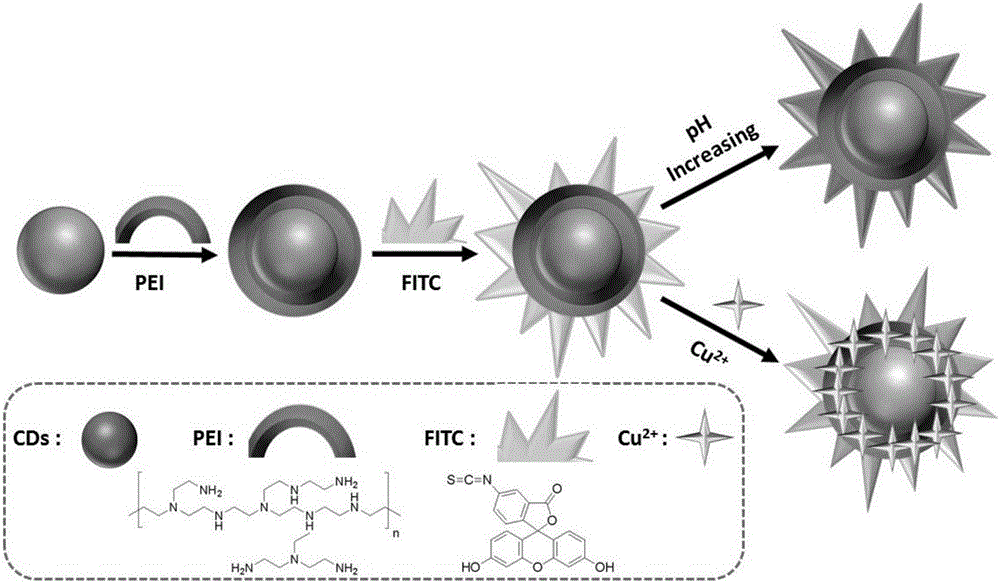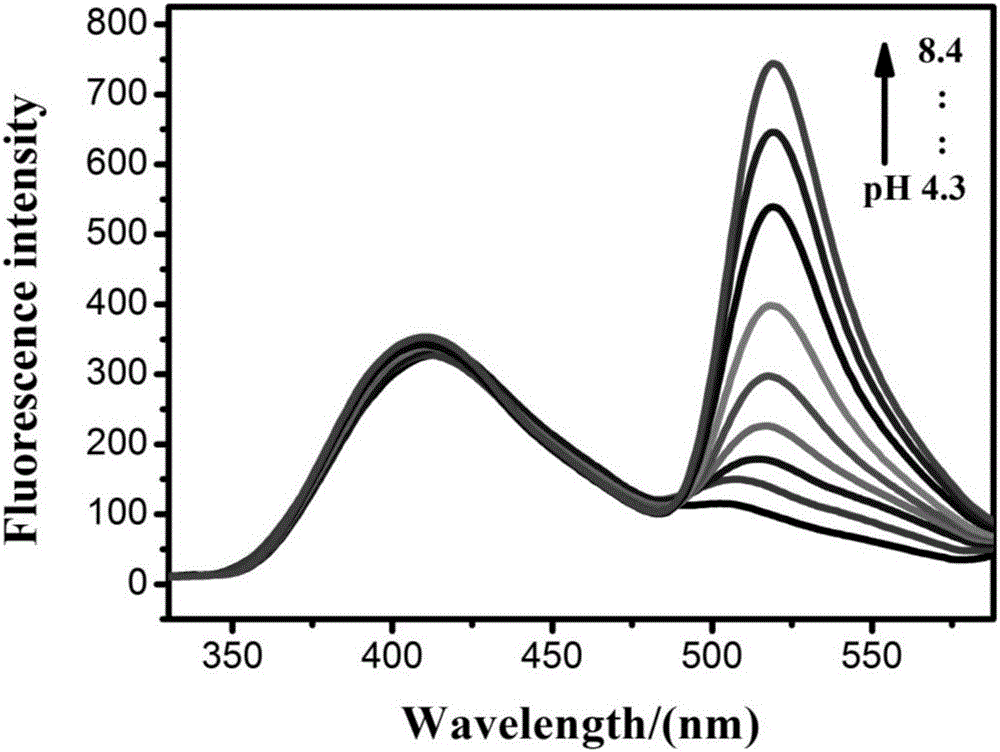Application of PEI modified carbon dot-FITC compound as rate fluorescent pH probe and Cu2+ fluorescent probe
A technology of ratiometric fluorescence and fluorescent probes, applied in the intersection of biology and materials science, and in the field of chemistry, can solve the problems of cumbersome detection and achieve the effects of simple process, easy operation and control, and low production cost
- Summary
- Abstract
- Description
- Claims
- Application Information
AI Technical Summary
Problems solved by technology
Method used
Image
Examples
Embodiment 1
[0041] Squeeze 30mL of fresh virgin fruit juice with a juicer and put it in a clean beaker; weigh 0.5g of β-cyclodextrin powder and add it to the virgin fruit juice, stir magnetically for 5min, transfer to an autoclave for hydrothermal reaction for 5h, and the reaction temperature is 120°C After the reaction, centrifuge (10000rpm, 15min), collect the upper layer dispersion, and filter to remove large particles; the upper layer dispersion is poured into a rotary evaporator, and rotary evaporated at a temperature of 40°C until there is no obvious Liquid, add 20mL of acetone and ethanol respectively, and centrifuge (12000rpm, 5min); repeat this centrifugation step three times, the lower sediment is CDs; prepare 1.0mg mL - 1 Add 0.1% PEI 0.2mL to 10mL CDs aqueous solution, and stir magnetically at room temperature for 0.5h; add 0.05mM FITC 10mL and continue magnetic stirring for 1h to prepare PEI-modified carbon dots-FITC complex.
[0042] The complex prepared above was divided i...
Embodiment 2
[0044] Squeeze 50mL of fresh virgin fruit juice with a juicer and put it in a clean beaker; weigh 0.7g of β-cyclodextrin powder and add it to the virgin fruit juice, stir magnetically for 7min, then transfer to an autoclave for hydrothermal reaction for 3h, and the reaction temperature is 140°C After the reaction, centrifuge (12000rpm, 10min), collect the upper layer dispersion, and filter to remove large particles; the upper layer dispersion is poured into a rotary evaporator, and rotary evaporated at a temperature of 60°C until there is no obvious Liquid, add 30mL of acetone and ethanol respectively, and centrifuge (12000rpm, 10min); repeat this centrifugation step three times, the lower sediment is CDs; prepare 0.5mgmL -1 Add 0.1% PEI 0.1mL to 10mL CDs aqueous solution, and magnetically stir for 1h at room temperature; add 0.05mM FITC 5mL and continue magnetically stirring for 2h to prepare PEI-modified carbon dots-FITC composite.
[0045] The complex prepared above was div...
Embodiment 3
[0047] Squeeze 80mL of fresh virgin fruit juice with a juicer and put it in a clean beaker; weigh 0.8g of β-cyclodextrin powder and add it to the virgin fruit juice, stir it magnetically for 10min, transfer it to the autoclave for 6h hydrothermal reaction, and the reaction temperature is 140℃ After the reaction, centrifuge (12000rpm, 10min), collect the upper layer dispersion, and filter to remove large particles; the upper layer dispersion is poured into a rotary evaporator, and rotary evaporated at a temperature of 60°C until there is no obvious Liquid, add 20mL of acetone and ethanol respectively, and centrifuge (12000rpm, 10min); repeat this centrifugation step three times, the lower sediment is CDs; prepare 0.5mgmL -1 Add 0.1% PEI 0.2mL to 10mL of CDs aqueous solution, and stir magnetically at room temperature for 1h; add 0.05mM FITC 5mL and continue magnetic stirring for 2h to prepare PEI-modified carbon dots-FITC complex.
[0048] The complex prepared above was divided ...
PUM
 Login to View More
Login to View More Abstract
Description
Claims
Application Information
 Login to View More
Login to View More - R&D
- Intellectual Property
- Life Sciences
- Materials
- Tech Scout
- Unparalleled Data Quality
- Higher Quality Content
- 60% Fewer Hallucinations
Browse by: Latest US Patents, China's latest patents, Technical Efficacy Thesaurus, Application Domain, Technology Topic, Popular Technical Reports.
© 2025 PatSnap. All rights reserved.Legal|Privacy policy|Modern Slavery Act Transparency Statement|Sitemap|About US| Contact US: help@patsnap.com



